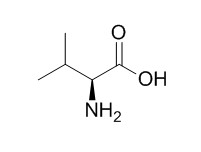L-Valine
L-Valine is an essential amino acid for the human body. L-Valine and L-isoleucine could be used in the supplements of low-protein corn and soybean meal all-vegetable diets for broilers.
Inquire / Order:
manager@chemfaces.com
Technical Inquiries:
service@chemfaces.com
Tel:
+86-27-84237783
Fax:
+86-27-84254680
Address:
1 Building, No. 83, CheCheng Rd., Wuhan Economic and Technological Development Zone, Wuhan, Hubei 430056, PRC
Providing storage is as stated on the product vial and the vial is kept tightly sealed, the product can be stored for up to
24 months(2-8C).
Wherever possible, you should prepare and use solutions on the same day. However, if you need to make up stock solutions in advance, we recommend that you store the solution as aliquots in tightly sealed vials at -20C. Generally, these will be useable for up to two weeks. Before use, and prior to opening the vial we recommend that you allow your product to equilibrate to room temperature for at least 1 hour.
Need more advice on solubility, usage and handling? Please email to: service@chemfaces.com
The packaging of the product may have turned upside down during transportation, resulting in the natural compounds adhering to the neck or cap of the vial. take the vial out of its packaging and gently shake to let the compounds fall to the bottom of the vial. for liquid products, centrifuge at 200-500 RPM to gather the liquid at the bottom of the vial. try to avoid loss or contamination during handling.
J Plant Biochem.Biotech.2024, 33:353-366.
Natural Product Communications2020, doi: 10.1177.
Int J Mol Sci.2024, 25(18):10219.
Foods.2022, 11(12):1708.
International Food Research Journal2018, 25(6):2560-2571
STAR Protoc.2024, 5(2):102990.
Phytomedicine.2019, 55:229-237
Sci Rep.2024, 14(1):23786.
Phytomedicine.2021, 93:153789.
LWT2021, 150:112021.
Related and Featured Products
Appl Environ Microbiol. 2007 Apr;73(7):2079-84.
L-valine production with pyruvate dehydrogenase complex-deficient Corynebacterium glutamicum.[Pubmed:
17293513 ]
METHODS AND RESULTS:
Corynebacterium glutamicum was engineered for the production of L-Valine from glucose by deletion of the aceE gene encoding the E1p enzyme of the pyruvate dehydrogenase complex and additional overexpression of the ilvBNCE genes encoding the L-Valine biosynthetic enzymes acetohydroxyacid synthase, isomeroreductase, and transaminase B.
In the absence of cellular growth, C. glutamicum DeltaaceE showed a relatively high intracellular concentration of pyruvate (25.9 mM) and produced significant amounts of pyruvate, L-alanine, and L-Valine from glucose as the sole carbon source. Lactate or acetate was not formed. Plasmid-bound overexpression of ilvBNCE in C. glutamicum DeltaaceE resulted in an approximately 10-fold-lower intracellular pyruvate concentration (2.3 mM) and a shift of the extracellular product pattern from pyruvate and L-alanine towards L-Valine.
CONCLUSIONS:
In fed-batch fermentations at high cell densities and an excess of glucose, C. glutamicum DeltaaceE(pJC4ilvBNCE) produced up to 210 mM L-Valine with a volumetric productivity of 10.0 mM h(-1) (1.17 g l(-1) h(-1)) and a maximum yield of about 0.6 mol per mol (0.4 g per g) of glucose.
Biotechnol Bioeng. 2005 Aug 5;91(3):356-68.
Application of model discriminating experimental design for modeling and development of a fermentative fed-batch L-valine production process.[Pubmed:
15984033]
A model discriminating experimental design approach for fed-batch processes has been developed and applied to the fermentative production of L-Valine by a genetically modified Corynebacterium glutamicum strain possessing multiple auxotrophies as an example.
METHODS AND RESULTS:
Being faced with the typical situation of uncertain model information based on preliminary experiments, model discriminating design was successfully applied to improve discrimination between five competing models. Within the same modeling and experimental design framework, also the planning of an optimized production process with respect to the total volumetric productivity is shown. Simulation results were experimentally affirmed, yielding an increased total volumetric productivity of 6.2 mM L-Valine per hour.
CONCLUSIONS:
However, also so far unknown metabolic mechanisms were observed in the optimized process, underlining the importance of process optimization during modeling to avoid problems of extreme extrapolation of model predictions during the final process optimization.



